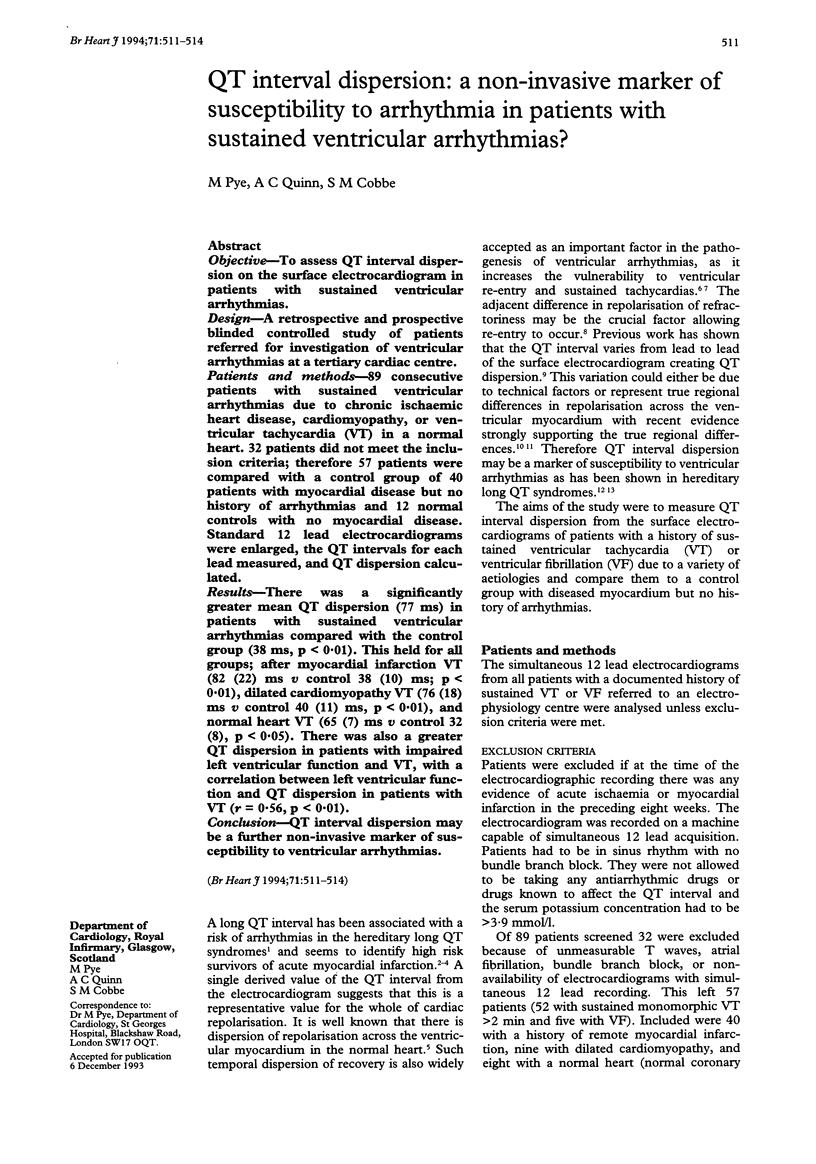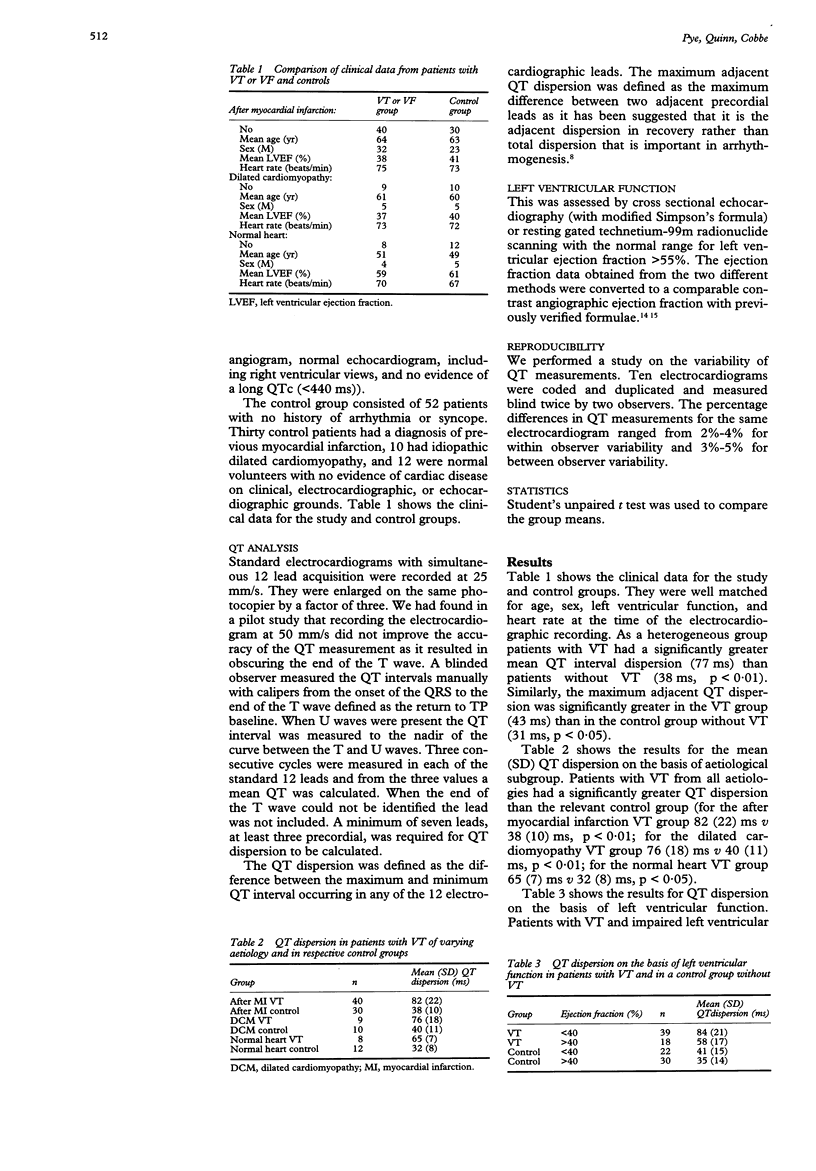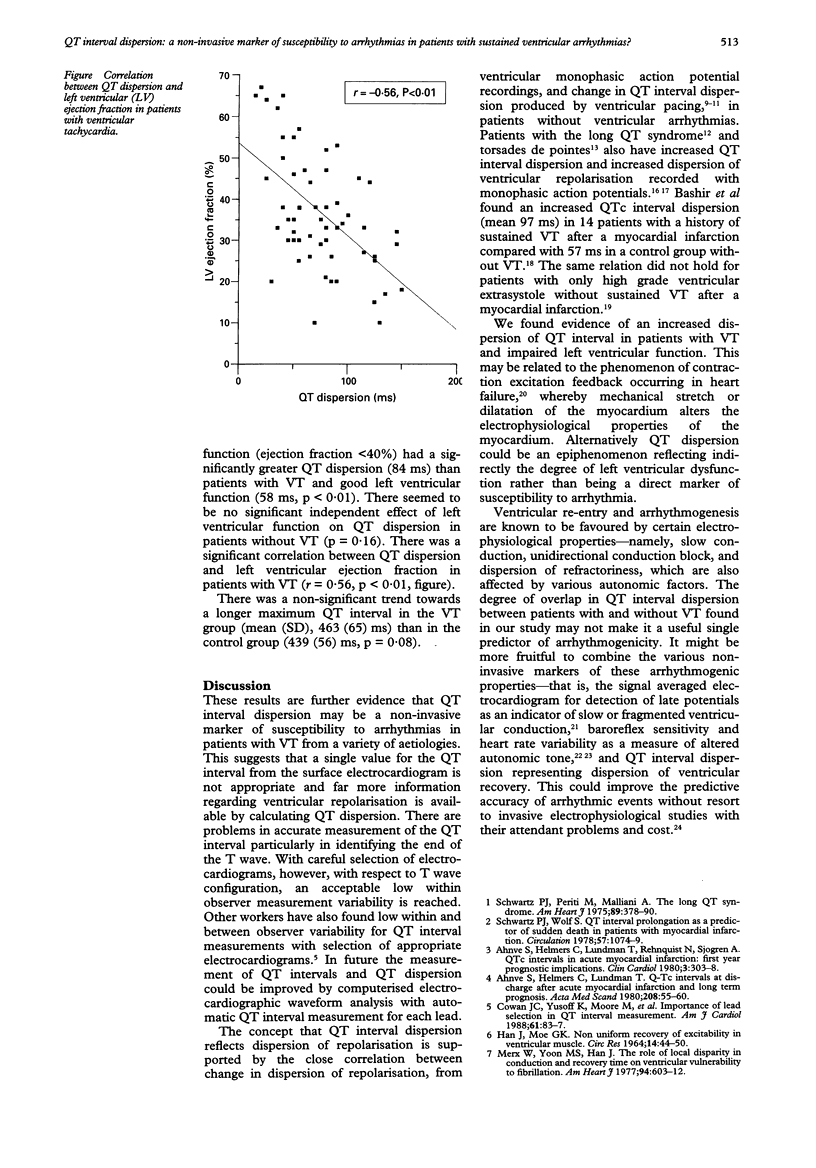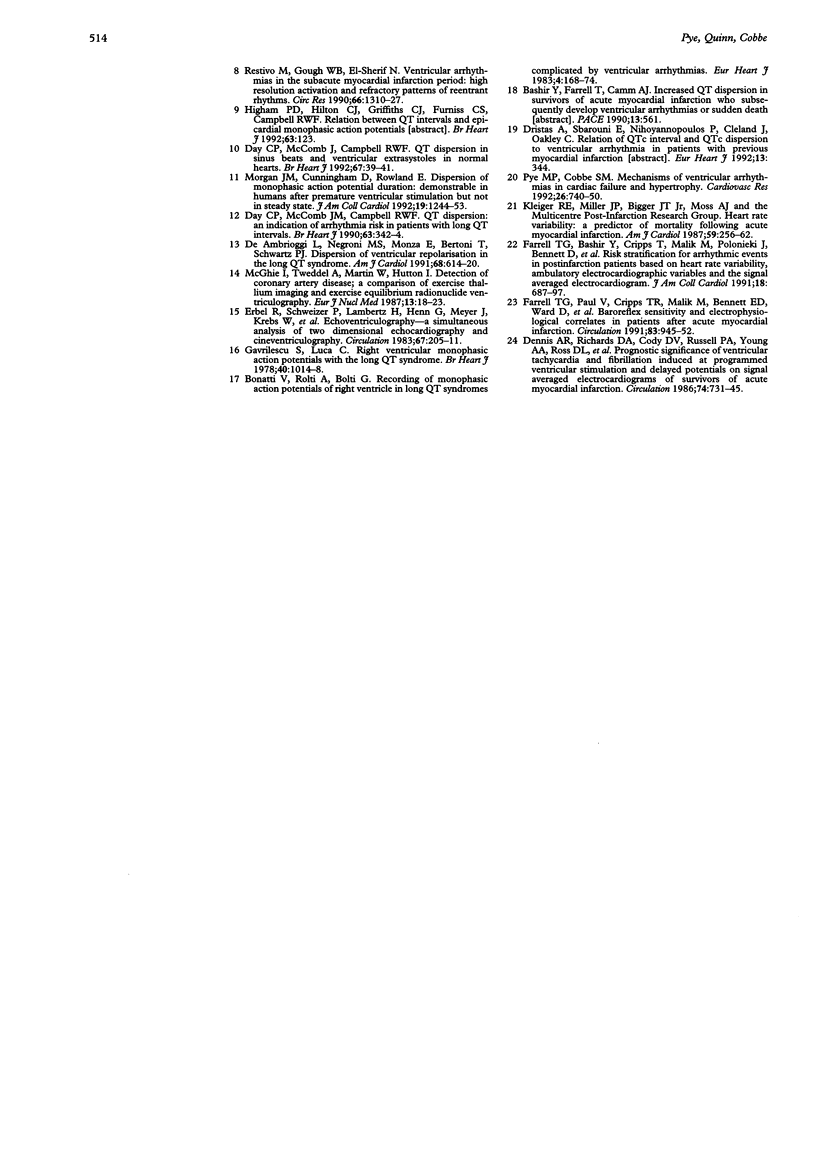Abstract
OBJECTIVE--To assess QT interval dispersion on the surface electrocardiogram in patients with sustained ventricular arrhythmias. DESIGN--A retrospective and prospective blinded controlled study of patients referred for investigation of ventricular arrhythmias at a tertiary cardiac centre. PATIENTS AND METHODS--89 consecutive patients with sustained ventricular arrhythmias due to chronic ischaemic heart disease, cardiomyopathy, or ventricular tachycardia (VT) in a normal heart. 32 patients did not meet the inclusion criteria; therefore 57 patients were compared with a control group of 40 patients with myocardial disease but no history of arrhythmias and 12 normal controls with no myocardial disease. Standard 12 lead electrocardiograms were enlarged, the QT intervals for each lead measured, and QT dispersion calculated. RESULTS--There was a significantly greater mean QT dispersion (77 ms) in patients with sustained ventricular arrhythmias compared with the control group (38 ms, p < 0.01). This held for all groups; after myocardial infarction VT (82 (22) ms v control 38 (10) ms; p < 0.01), dilated cardiomyopathy VT (76 (18) ms v control 40 (11) ms, p < 0.01), and normal heart VT (65 (7) ms v control 32 (8), p < 0.05). There was also a greater QT dispersion in patients with impaired left ventricular function and VT, with a correlation between left ventricular function and QT dispersion in patients with VT (r = 0.56, p < 0.01). CONCLUSION--QT interval dispersion may be a further non-invasive marker of susceptibility to ventricular arrhythmias.
Full text
PDF



Selected References
These references are in PubMed. This may not be the complete list of references from this article.
- Ahnve S., Helmers C., Lundman T. QTc intervals at discharge after acute myocardial infarction and long-term prognosis. Acta Med Scand. 1980;208(1-2):55–60. doi: 10.1111/j.0954-6820.1980.tb01150.x. [DOI] [PubMed] [Google Scholar]
- Ahnve S., Helmers C., Lundman T., Rehnqvist N., Sjögren A. QTc intervals in acute myocardial infarction: first-year prognostic implications. Clin Cardiol. 1980 Oct;3(5):303–308. doi: 10.1002/clc.4960030403. [DOI] [PubMed] [Google Scholar]
- Bonatti V., Rolli A., Botti G. Recording of monophasic action potentials of the right ventricle in long QT syndromes complicated by severe ventricular arrhythmias. Eur Heart J. 1983 Mar;4(3):168–179. doi: 10.1093/oxfordjournals.eurheartj.a061436. [DOI] [PubMed] [Google Scholar]
- Cowan J. C., Yusoff K., Moore M., Amos P. A., Gold A. E., Bourke J. P., Tansuphaswadikul S., Campbell R. W. Importance of lead selection in QT interval measurement. Am J Cardiol. 1988 Jan 1;61(1):83–87. doi: 10.1016/0002-9149(88)91309-4. [DOI] [PubMed] [Google Scholar]
- Day C. P., McComb J. M., Campbell R. W. QT dispersion in sinus beats and ventricular extrasystoles in normal hearts. Br Heart J. 1992 Jan;67(1):39–41. doi: 10.1136/hrt.67.1.39. [DOI] [PMC free article] [PubMed] [Google Scholar]
- Day C. P., McComb J. M., Campbell R. W. QT dispersion: an indication of arrhythmia risk in patients with long QT intervals. Br Heart J. 1990 Jun;63(6):342–344. doi: 10.1136/hrt.63.6.342. [DOI] [PMC free article] [PubMed] [Google Scholar]
- De Ambroggi L., Negroni M. S., Monza E., Bertoni T., Schwartz P. J. Dispersion of ventricular repolarization in the long QT syndrome. Am J Cardiol. 1991 Sep 1;68(6):614–620. doi: 10.1016/0002-9149(91)90353-m. [DOI] [PubMed] [Google Scholar]
- Denniss A. R., Richards D. A., Cody D. V., Russell P. A., Young A. A., Cooper M. J., Ross D. L., Uther J. B. Prognostic significance of ventricular tachycardia and fibrillation induced at programmed stimulation and delayed potentials detected on the signal-averaged electrocardiograms of survivors of acute myocardial infarction. Circulation. 1986 Oct;74(4):731–745. doi: 10.1161/01.cir.74.4.731. [DOI] [PubMed] [Google Scholar]
- Erbel R., Schweizer P., Lambertz H., Henn G., Meyer J., Krebs W., Effert S. Echoventriculography -- a simultaneous analysis of two-dimensional echocardiography and cineventriculography. Circulation. 1983 Jan;67(1):205–215. doi: 10.1161/01.cir.67.1.205. [DOI] [PubMed] [Google Scholar]
- Farrell T. G., Paul V., Cripps T. R., Malik M., Bennett E. D., Ward D., Camm A. J. Baroreflex sensitivity and electrophysiological correlates in patients after acute myocardial infarction. Circulation. 1991 Mar;83(3):945–952. doi: 10.1161/01.cir.83.3.945. [DOI] [PubMed] [Google Scholar]
- Gavrilescu S., Luca C. Right ventricular monophasic action potentials in patients with long QT syndrome. Br Heart J. 1978 Sep;40(9):1014–1018. doi: 10.1136/hrt.40.9.1014. [DOI] [PMC free article] [PubMed] [Google Scholar]
- HAN J., MOE G. K. NONUNIFORM RECOVERY OF EXCITABILITY IN VENTRICULAR MUSCLE. Circ Res. 1964 Jan;14:44–60. doi: 10.1161/01.res.14.1.44. [DOI] [PubMed] [Google Scholar]
- Kleiger R. E., Miller J. P., Bigger J. T., Jr, Moss A. J. Decreased heart rate variability and its association with increased mortality after acute myocardial infarction. Am J Cardiol. 1987 Feb 1;59(4):256–262. doi: 10.1016/0002-9149(87)90795-8. [DOI] [PubMed] [Google Scholar]
- McGhie I., Martin W., Tweddel A., Hutton I. The detection of coronary artery disease: a comparison of exercise thallium imaging and exercise equilibrium radionuclide ventriculography. Eur J Nucl Med. 1987;13(1):18–23. doi: 10.1007/BF00252640. [DOI] [PubMed] [Google Scholar]
- Merx W., Yoon M. S., Han J. The role of local disparity in conduction and recovery time on ventricular vulnerability to fibrillation. Am Heart J. 1977 Nov;94(5):603–610. doi: 10.1016/s0002-8703(77)80130-0. [DOI] [PubMed] [Google Scholar]
- Morgan J. M., Cunningham D., Rowland E. Dispersion of monophasic action potential duration: demonstrable in humans after premature ventricular extrastimulation but not in steady state. J Am Coll Cardiol. 1992 May;19(6):1244–1253. doi: 10.1016/0735-1097(92)90331-g. [DOI] [PubMed] [Google Scholar]
- Pye M. P., Cobbe S. M. Mechanisms of ventricular arrhythmias in cardiac failure and hypertrophy. Cardiovasc Res. 1992 Aug;26(8):740–750. doi: 10.1093/cvr/26.8.740. [DOI] [PubMed] [Google Scholar]
- Restivo M., Gough W. B., el-Sherif N. Ventricular arrhythmias in the subacute myocardial infarction period. High-resolution activation and refractory patterns of reentrant rhythms. Circ Res. 1990 May;66(5):1310–1327. doi: 10.1161/01.res.66.5.1310. [DOI] [PubMed] [Google Scholar]
- Schwartz P. J., Periti M., Malliani A. The long Q-T syndrome. Am Heart J. 1975 Mar;89(3):378–390. doi: 10.1016/0002-8703(75)90089-7. [DOI] [PubMed] [Google Scholar]
- Schwartz P. J., Wolf S. QT interval prolongation as predictor of sudden death in patients with myocardial infarction. Circulation. 1978 Jun;57(6):1074–1077. doi: 10.1161/01.cir.57.6.1074. [DOI] [PubMed] [Google Scholar]


